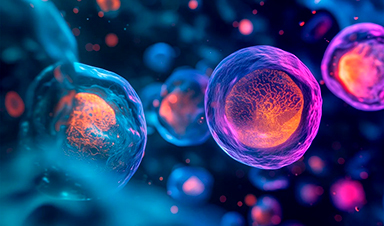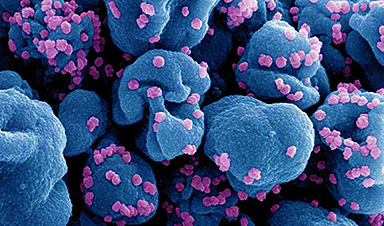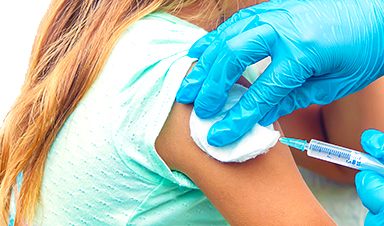New research offers a potential explanation for the formation of early Earth protocells.
Few questions have captivated humankind more than the mystery of life's origins on Earth. How did the first living cells emerge? How did these early protocells develop the structural membranes essential for thriving and eventually assembling into complex organisms?
New research from the lab of University of California San Diego Professor of Chemistry and Biochemistry Neal Devaraj has uncovered a plausible explanation involving the reaction between two simple molecules. This work appears in Nature Chemistry.
The Role of Lipid Membranes in Life
Life on Earth requires lipid membranes – the structure of a cell that houses its interior mechanics and acts as a scaffold for many biological reactions. Lipids are made from long chains of fatty acids, but before the existence of complex life, how did these first cell membranes form from the simple molecules present on Earth billions of years ago?
Scientists believe that simple molecules of short fatty chains of fewer than 10 carbon-carbon bonds (complex fatty chains can have nearly twice that many bonds) were abundant on early Earth. However, molecules with longer chain lengths are necessary to form vesicles, the compartments that house a cell's complicated machinery.
Time-lapse fluorescence microscopy video showing vesicle formation (images were taken every 2 minutes for 4 hours). Credit: Neal Devaraj lab / UC San Diego
While it may have been possible for some simple fatty molecules to form lipid compartments on their own, the molecules would be needed in very high concentrations that likely did not exist on a prebiotic Earth – a time when conditions on Earth may have been hospitable to life but none yet existed.
"On the surface, it may not seem novel because lipid production happens in the presence of enzymes all the time," stated Devaraj, who is also the Murray Goodman Endowed Chair in Chemistry and Biochemistry. "But over four billion years ago, there were no enzymes. Yet somehow these first protocell structures were formed. How? That's the question we were trying to answer."
A Groundbreaking Discovery: Lipid Formation Without Enzymes
To uncover an explanation for these first lipid membranes, Devaraj's team started with two simple molecules: an amino acid named cysteine and a short-chain choline thioester, similar to molecules involved in the biochemical formation and degradation of fatty acids.
The researchers used silica glass as a mineral catalyst because the negatively charged silica was attracted to the positively charged thioester. On the silica surface, the cysteine and thioesters spontaneously reacted to form lipids, generating protocell-like membrane vesicles stable enough to sustain biochemical reactions. This happened at lower concentrations than what would be needed in the absence of a catalyst.
"Part of the work we're doing is trying to understand how life can emerge in the absence of life. How did that matter-to-life transition initially occur?" said Devaraj. "Here we have provided one possible explanation of what could have happened."
Reference: "Protocells by spontaneous reaction of cysteine with short-chain thioesters" by Christy J. Cho, Taeyang An, Yei-Chen Lai, Alberto Vázquez-Salazar, Alessandro Fracassi, Roberto J. Brea, Irene A. Chen and Neal K. Devaraj, 30 October 2024, Nature Chemistry.
DOI: 10.1038/s41557-024-01666-y
This research was supported, in part, by National Science Foundation (EF-1935372) and the National Institutes of Health (R35-GM141939).
News
Older chemical libraries show promise for fighting resistant strains of COVID-19 virus
SARS‑CoV‑2, the virus that causes COVID-19, continues to mutate, with some newer strains becoming less responsive to current antiviral treatments like Paxlovid. Now, University of California San Diego scientists and an international team of [...]
Lower doses of immunotherapy for skin cancer give better results, study suggests
According to a new study, lower doses of approved immunotherapy for malignant melanoma can give better results against tumors, while reducing side effects. This is reported by researchers at Karolinska Institutet in the Journal of the National [...]
Researchers highlight five pathways through which microplastics can harm the brain
Microplastics could be fueling neurodegenerative diseases like Alzheimer's and Parkinson's, with a new study highlighting five ways microplastics can trigger inflammation and damage in the brain. More than 57 million people live with dementia, [...]
Tiny Metal Nanodots Obliterate Cancer Cells While Largely Sparing Healthy Tissue
Scientists have developed tiny metal-oxide particles that push cancer cells past their stress limits while sparing healthy tissue. An international team led by RMIT University has developed tiny particles called nanodots, crafted from a metallic compound, [...]
Gold Nanoclusters Could Supercharge Quantum Computers
Researchers found that gold “super atoms” can behave like the atoms in top-tier quantum systems—only far easier to scale. These tiny clusters can be customized at the molecular level, offering a powerful, tunable foundation [...]
A single shot of HPV vaccine may be enough to fight cervical cancer, study finds
WASHINGTON -- A single HPV vaccination appears just as effective as two doses at preventing the viral infection that causes cervical cancer, researchers reported Wednesday. HPV, or human papillomavirus, is very common and spread [...]
New technique overcomes technological barrier in 3D brain imaging
Scientists at the Swiss Light Source SLS have succeeded in mapping a piece of brain tissue in 3D at unprecedented resolution using X-rays, non-destructively. The breakthrough overcomes a long-standing technological barrier that had limited [...]
Scientists Uncover Hidden Blood Pattern in Long COVID
Researchers found persistent microclot and NET structures in Long COVID blood that may explain long-lasting symptoms. Researchers examining Long COVID have identified a structural connection between circulating microclots and neutrophil extracellular traps (NETs). The [...]
This Cellular Trick Helps Cancer Spread, but Could Also Stop It
Groups of normal cbiells can sense far into their surroundings, helping explain cancer cell migration. Understanding this ability could lead to new ways to limit tumor spread. The tale of the princess and the [...]
New mRNA therapy targets drug-resistant pneumonia
Bacteria that multiply on surfaces are a major headache in health care when they gain a foothold on, for example, implants or in catheters. Researchers at Chalmers University of Technology in Sweden have found [...]
Current Heart Health Guidelines Are Failing To Catch a Deadly Genetic Killer
New research reveals that standard screening misses most people with a common inherited cholesterol disorder. A Mayo Clinic study reports that current genetic screening guidelines overlook most people who have familial hypercholesterolemia, an inherited disorder that [...]
Scientists Identify the Evolutionary “Purpose” of Consciousness
Summary: Researchers at Ruhr University Bochum explore why consciousness evolved and why different species developed it in distinct ways. By comparing humans with birds, they show that complex awareness may arise through different neural architectures yet [...]
Novel mRNA therapy curbs antibiotic-resistant infections in preclinical lung models
Researchers at the Icahn School of Medicine at Mount Sinai and collaborators have reported early success with a novel mRNA-based therapy designed to combat antibiotic-resistant bacteria. The findings, published in Nature Biotechnology, show that in [...]
New skin-permeable polymer delivers insulin without needles
A breakthrough zwitterionic polymer slips through the skin’s toughest barriers, carrying insulin deep into tissue and normalizing blood sugar, offering patients a painless alternative to daily injections. A recent study published in the journal Nature examines [...]
Multifunctional Nanogels: A Breakthrough in Antibacterial Strategies
Antibiotic resistance is a growing concern - from human health to crop survival. A new study successfully uses nanogels to target and almost entirely inhibit the bacteria P. Aeruginosa. Recently published in Angewandte Chemie, the study [...]
Nanoflowers rejuvenate old and damaged human cells by replacing their mitochondria
Biomedical researchers at Texas A&M University may have discovered a way to stop or even reverse the decline of cellular energy production—a finding that could have revolutionary effects across medicine. Dr. Akhilesh K. Gaharwar [...]





















